ALONG THE PYRENEES: BARCELONA – HONDARRIBIA - 1997
 Monday, March 2, 2015 at 04:01PM
Monday, March 2, 2015 at 04:01PM
One of our fellow hikers on the Tour du Mont Blanc had heartily recommended hiking in the Pyrenees. We found a trip that met all our requirements: twelve days was the right sort of length; “rigorous” was the right level of difficulty (we were much younger then); and, best of all, it was to be led by a guide renowned for his knowledge of the flora, fauna and culture of the region – a well-known raconteur who would be the life and soul of the party every step of the way. Or so the brochure promised.
We arrived in Barcelona, along with a certain percentage of our luggage. The next morning, having been happily reunited with the remainder of it, we met up with our group of fourteen and embarked on a five-hour drive towards the Pyrenees. Our destination for the first night was the tiny village of Arties in the Vall d'Aran, an area that had been independent for much of its history because snow made it inaccessible for eight months of the year. Typically, the early hours of any trip are spent trying to take the measure of one's fellow hikers, and in particular to ferret out their previous hiking experience without sounding either boastful or insecure. Underlying our polite inquiries is the hope that there will always be someone – anyone - slower than us on the trail. Perhaps the most surprising aspect of that first day was the uncommunicative demeanor of our guide; far from keeping us entertained, as his advance billing had claimed he would, he barely spoke a word. We assumed it was simply going to take him a while to warm up to the group. Little did we know.
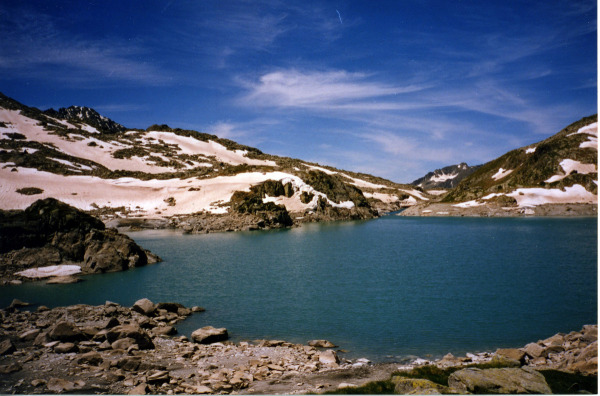 L'Stany de MarOur warm-up hike the next morning to L'Stany de Mar gave a sense of the isolation we would be encountering. That day, in eight miles of hiking, we saw no sign of habitation and exactly four other walkers. The next day the hike began in earnest. The last part of it was over a snowfield and we had to be roped together as the slide down, had one slipped, would have been very long. And the trek back up even longer. There were vultures enjoying a horse that had been trapped under the snow since the previous summer.
L'Stany de MarOur warm-up hike the next morning to L'Stany de Mar gave a sense of the isolation we would be encountering. That day, in eight miles of hiking, we saw no sign of habitation and exactly four other walkers. The next day the hike began in earnest. The last part of it was over a snowfield and we had to be roped together as the slide down, had one slipped, would have been very long. And the trek back up even longer. There were vultures enjoying a horse that had been trapped under the snow since the previous summer.
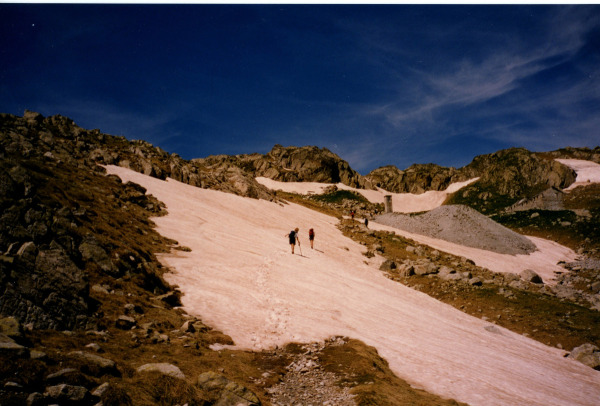 Snowfield south of ArtiesAt the top of the pass we were directly on the frontier between Spain and France, and flags fluttered proudly.There we ate our lunch of omelet sandwiches, only to discover that the local goats had a pronounced fondness for eggs, and were eager to join us for lunch. Our Basque guides were more than equal to the task of fending them off.
Snowfield south of ArtiesAt the top of the pass we were directly on the frontier between Spain and France, and flags fluttered proudly.There we ate our lunch of omelet sandwiches, only to discover that the local goats had a pronounced fondness for eggs, and were eager to join us for lunch. Our Basque guides were more than equal to the task of fending them off.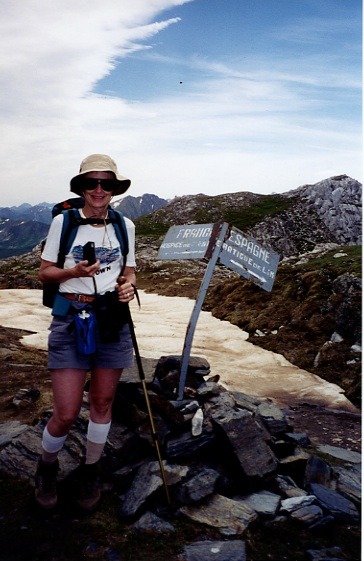 Frontier
Frontier
We spent the night in Benasque, the easternmost township in Aragon and once a getaway destination for wealthy Aragonese. As in most of the villages on this trip, we encountered few people who could speak English. French was a bit more useful, but fortunately one of us prides herself on her command of Spanish, so the other of us felt confident that we would be able to navigate any linguistic barriers we might come across. Little did she know.
The drive had taken us through the narrow streets of picturesque villages; the hiking through fields brilliant with gentians, edelweiss and other wildflowers; and the meal that evening was a superb paella. None of these, however, did anything to lighten the mood of our guide. He was still maintaining a strange silence that was beginning to concern us all.
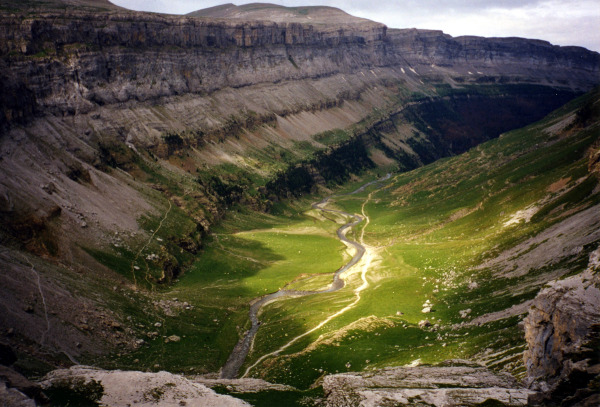 Ordesa National ParkThe following day we entered Ordesa National Park, Spain's answer to Yosemite. While it doesn't quite match the grandeur of the latter, it does feature sheer walls dropping off to the valley below. That valley was our destination, and narrow paths along precipitous ledges were the only way to get to it, so backing out was not an option. And once down at the bottom, there was a canyon wall on the other side to be scaled. 2,800 feet of it was simply a long, hard slog upwards, but the very last part was a sheer rock face, with just enough rock formations to serve as toeholds.
Ordesa National ParkThe following day we entered Ordesa National Park, Spain's answer to Yosemite. While it doesn't quite match the grandeur of the latter, it does feature sheer walls dropping off to the valley below. That valley was our destination, and narrow paths along precipitous ledges were the only way to get to it, so backing out was not an option. And once down at the bottom, there was a canyon wall on the other side to be scaled. 2,800 feet of it was simply a long, hard slog upwards, but the very last part was a sheer rock face, with just enough rock formations to serve as toeholds.
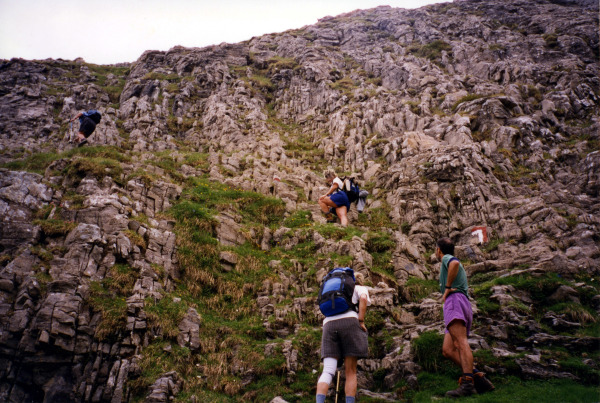 Approach to Ordesa National ParkBy this time our strong, silent guide no longer appeared to care whether we made it or not; he had acted disengaged all day, and now he seemed eager to get away from us altogether. We scrambled up to the top, and from there we were able to see our goal, the Rifugio Goriz, where we were to spend the night. After eight grueling hours we looked forward to a pleasant evening of eating and drinking, followed by a well-deserved night's sleep.
Approach to Ordesa National ParkBy this time our strong, silent guide no longer appeared to care whether we made it or not; he had acted disengaged all day, and now he seemed eager to get away from us altogether. We scrambled up to the top, and from there we were able to see our goal, the Rifugio Goriz, where we were to spend the night. After eight grueling hours we looked forward to a pleasant evening of eating and drinking, followed by a well-deserved night's sleep.
Refugio Goriz
The rifugio has a splendid location at 7,000 feet elevation, among alpine meadows. Behind it rises the spectacular Monte Perdido. Those are its good points. The flip side is a much longer list. It was primitive, and had neither electricity nor potable water. (How in the world were we going to swallow our daily dose of high blood pressure medicine and statins, which we now desperately needed?) The latrines were 100 yards removed from the main building, accessible only by a catwalk across something we hoped was mud. It was exceedingly tricky in the pitch dark, as were the basic formalities once you made it to the latrine. The rifugio was poorly managed at best. Among its many shortcomings: it contained only six (warm) beers for 50 people. For one of us, this was a catastrophe. Also, groups were fed in order of their arrival, and our guide, who at this point appeared incapable of rational thinking, had neglected to inform the manager that our group existed. By the time we were allowed to enter the eating area we were lucky to get even the scant remains of some cold lentil soup.
Topping the evening off, we climbed upstairs to the ”dormitory.” That featured three-tiered bunks, ten across, each of the three levels being one continuous slab to accommodate ten bodies. Having been the last to eat, we were also the last to choose our sleeping areas, and by the time we got there, people were splayed out every which way, not honoring the invisible dividing lines that delineated what should have been their allotted space. One had to burrow in from the foot end and wedge oneself between large unwashed mountaineers, now sleeping soundly and snoring vigorously, but intending to wake up at about 4 am to have a go at Mount Perdido.
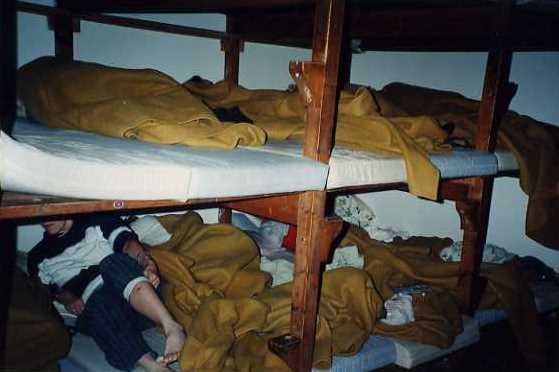 Dormitory
Dormitory
And that wasn't all. At breakfast the next morning we discovered that those mountaineers had gobbled up all the available food except for a few slices of stale bread. The only bright spots on the horizon were the facts that we would soon be seeing this rifugio in our rear view mirrors, and that describing our night there would be good cocktail party fodder. Even your dearest friends aren't really interested in hearing about your night in a 5-star resort.
Our reward for the horrors of the previous evening was the walk out of Ordesa National Park. The views were stupendous as we made our way down a vast canyon with towering cliffs on either side. Using our binoculars we were able to spot the aforementioned and well-breakfasted mountaineers on Mount Perdido. We hoped they felt that they had overeaten at breakfast. Before long we were walking along the edge of the crystal clear Arazas River as it tumbled over dozens of cascades on its way to the valley floor.
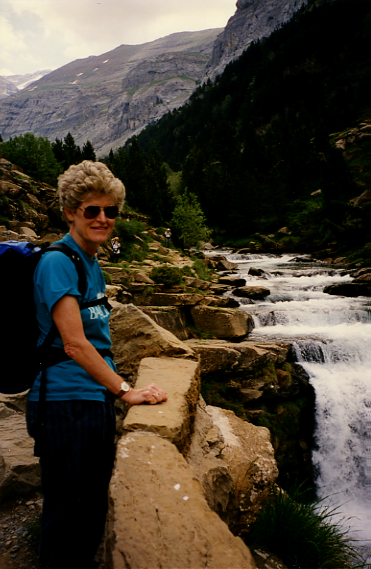 Arazas Rier
Arazas Rier
There was a carpark at the exit of the park, and there we dived into a lavish lunch of beans and chorizo, salad, white asparagus, spaghetti, veal, chicken, pork, and a sour milk dessert called natilla. Our notes describe the meal in mouth-watering detail; in fact, neither of us actually remembers eating it. Possibly we fantasized the whole thing, still reeling from the meager offerings at the rifugio.
At the hotel in Torla that night the issue of our guide came to a head. He had retreated to his room on arrival, and was only seen again the next morning when his wife came to fetch him and spirit him away. Something was clearly amiss and we could only hope that we hadn't tipped him over the edge. That same morning an extremely handsome ski instructor from a nearby village appeared to take his place. This met with our approval, even before we found out that he was also knowledgeable about the area. Among the interesting things he told us was the fact that the snow that we could see was brown because it was covered with sand that had blown in from the Sahara (which is not right next door). There are a great many vultures in the Pyrenees, and our new guide explained the dietary habits of some of them. These known as quebrantahuesos drop bones from great heights in order to crack them and extract the marrow. He went on to say that for some reason the behavior patterns of vultures in that region seem to have undergone a change; no longer satisfied with the carrion that has kept them going for generations, they have begun to develop a taste for young, live animals, especially tender newborns. We did our best to appear elderly and tough.
That evening in Panticosa there was a birthday celebration for one of the guests. We joined in the festivities a trifle more enthusiastically than our ages warranted, and at its conclusion we felt the need for some fresh air. After roaming around the charming little ski resort we returned to the hotel, only to realize that we had left the room key in the room. The desk clerk spoke no English, so it fell to Ellie, who had boasted so much about her Spanish linguistic abilities, to extract a spare key from said clerk. Drawing herself up regally, she proudly opened the conversation with “Cuántos años es usted?” Confused, but ever polite, he told her his age. This only served to bewilder her further, as it wasn't the answer to the question she thought she had asked. But intent on keeping the conversation going, she countered with the announcement that she herself was sixteen. He tried not to smirk, and they appeared to be off and running. How this riveting exchange would have ended is difficult to say, but after a few more non sequiturs, Suzy, who was thoroughly enjoying the spectacle of pride going before a fall but aware that it was not getting them any closer to their room, quietly pointed to the row of keys behind the desk. She marched off to bed, leaving the murderer of the Spanish language to practice what little of it she knew with the long-suffering desk clerk.
The next day was cold and rainy, and most of us opted to forego the hike and ride in the van to the Monastery of San Juan de la Peña. The monastery was was built in the 11th century atop a cliff, and is located on the famous pilgrimage route to Santiago de la Compostela. There we were treated to the haunting sounds of young children singing a Mass with a priest under a tree.
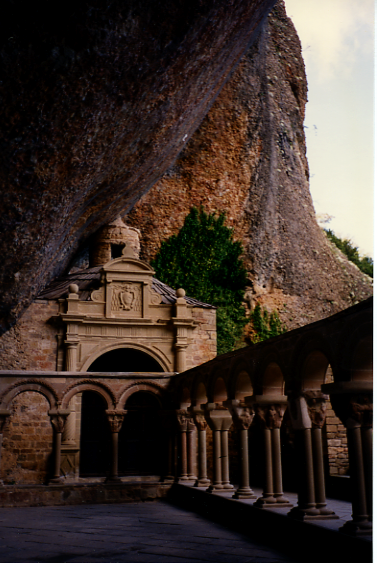 Monastery of San Juan de la Peña
Monastery of San Juan de la Peña
Our final day called for a strenuous five-hour hike to the Collado de Petraficha, and after an almost equally long descent we met up with our van and those who had chosen not to hike that day.
We are always pleased to see people younger than us opt out of a hike because it gives us a sense of superiority that we don't get very often. On this occasion those young people had local melons and beer waiting for us, which they had iced in a stream. One could not ask for better traveling companions than that.
From that point it was a long van ride to Hondarribia, an old Basque fishing village on the Bay of Biscay near the French border. Our final meal was al fresco at a restaurant overlooking the harbor busy with shipping, rowing and racing boats. The langoustines and white asparagus displayed Basque cuisine at its finest. Our poignant goodbyes after the meal were very similar to those at the end of the Tour du Mont Blanc. We congratulated each other on having completed the walk. We expressed our pleasure at having hiked together and voiced the hope of perhaps meeting to do it gain. We made vows to keep in touch. For all of us there was a well-earned feeling of accomplishment and camaraderie, and for the two of us, the certain intention that we would indeed hike again.
click here to see a gallery of the photos

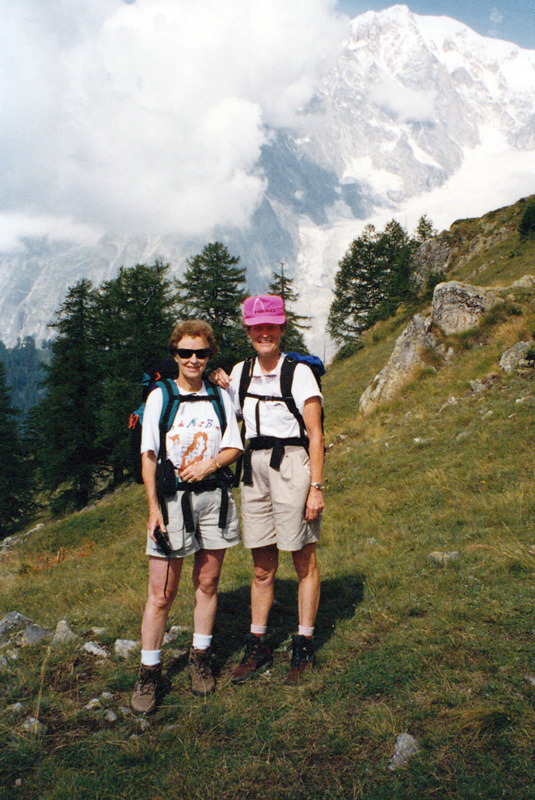
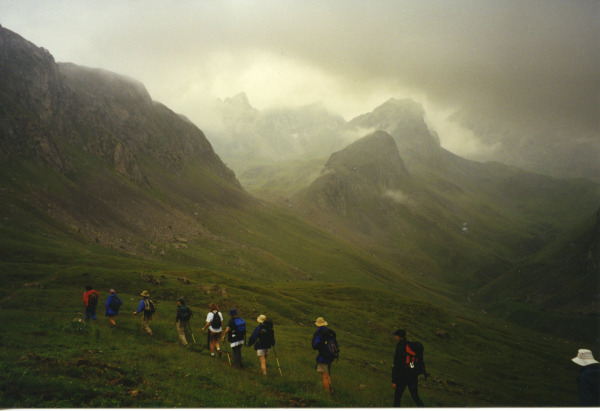
Reader Comments